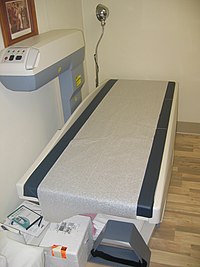
Photo from wikipedia
World Congress on Osteoporosis, Osteoarthritis and Musculoskeletal Diseases (WCO-IOF-ESCEO 2019): Plenary Lectures Abstracts # International Osteoporosis Foundation and National Osteoporosis Foundation 2019 PL1 WHEN AND WHY USE A BONE-FORMING AGENT?… Click to show full abstract
World Congress on Osteoporosis, Osteoarthritis and Musculoskeletal Diseases (WCO-IOF-ESCEO 2019): Plenary Lectures Abstracts # International Osteoporosis Foundation and National Osteoporosis Foundation 2019 PL1 WHEN AND WHY USE A BONE-FORMING AGENT? E. McCloskey Department of Oncology & Metabolism, University of Sheffield, Sheffield, United Kingdom The last few years have seen exciting advances in our knowledge of musculoskeletal biology and the comparative efficacy of established and novel bone-forming agents in clinical trials. Of the two questions raised here, the reason why to use boneforming agents is the easiest to address. The natural experiments that led to the discovery of sclerostin deficiency, and its impact on bone mass and strength, has enabled the pharmacological development of sclerostint a rge t ed monoc lona l an t ibod ies , one o f which (romosozumab) is now entering clinical practice. In a large placebo-controlled study, and more importantly in a head-tohead trial with the most widely used treatment for osteoporosis, alendronic acid, romosozumab has shown superior increases in bone density at all skeletal sites, with a consequent greater and more rapid decrease in fracture rates. Furthermore, teriparatide, which has been available for the treatment of osteoporosis for approximately 16 years, has also recently shown superior antifracture efficacy in a head-to-head trial with oral risedronate across a wide range of vertebral and clinical fracture outcomes. Thus, the reason why to use bone-forming agents is straightforward; they have a different mechanism of action to antiresorptives which leads to more marked improvements in skeletal mass and/or structure with a consequent greater efficacy in reducing fracture risk. When to use a bone-forming agent? The clinician’s choice is often impacted by external influences, a common one being the presence of a steep cost gradient across the available treatment options. It is easily concluded that more expensive agents, such as bone-forming treatments, will be of greatest merit and utility when targeted to patients at high risk of fracture, where the greater absolute risk reduction will benefit the patient and address some of the concerns around costeffectiveness. Indeed, this high risk population was reflected in the inclusion criteria for the two recent head-to-head studies. There is therefore a need to characterise high risk. While this has frequently been achieved by providing clinical exemplars of high risk (e.g. identification of subgroups with very low BMD T-scores, previous multiple fractures or a combination of clinical risk factors), the availability of risk assessment tools such as FRAX are likely to be of use in this setting. Indeed, several authorities, most notably the National Institute for Health and Care Excellence (NICE) in the UK, now incorporate such tools into health economic analyses that underpin clinical guideline development. This and other strategies will be explored in this plenary lecture. Disclosures: Grants/research support from Amgen, ARUK, AstraZeneca, Consilient Healthcare, GSK, Hologic, I3 Innovus, Internis, IOF, Lilly, Merck, MRC, Novartis, Pfizer, Roche, Sanofi-Aventis, UCB, Unilever. Consultant for Amgen, Consilient Healthcare, Fresenius Kabi, GSK, Synexus, and UCB. Speaking fees from Agnovos, Amgen, AstraZeneca, Consilient Healthcare, GSK, Hologic, Internis, Lilly, Pfizer, Roche, Servier, and UCB. PL2 BONE FRAGILITY AND ITS TREATMENT IN CHRONIC RENAL FAILURE P. R. Ebeling Bone and Muscle Health Research Group, Department of Medicine, School of Clinical Sciences at Monash Health, Faculty of Medicine, Nursing and Health Sciences, Monash University, Clayton, Australia Chronic kidney disease (CKD) is commonly associated with ageing. The majority has stage 1, 2 or 3 CKD with estimated glomerular filtration rates (eGFR) of 90 mLs/min, 60-89 mLs/min, and 30-59 mLs/min, respectively. However, many have stage 4 CKD (15-29 mLs/min) and stage 5 CKD (<15 mLs/min) or are on dialysis. CKD is associated with excess Osteoporosis International (2019) 30 (Suppl 2):S157–S162 https://doi.org/10.1007/s00198-019-04988-7
Journal Title: Osteoporosis International
Year Published: 2019
Link to full text (if available)
Share on Social Media: Sign Up to like & get
recommendations!